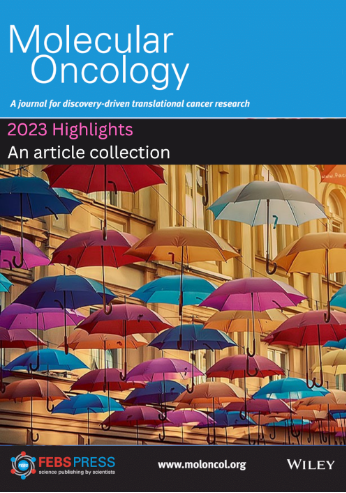在癌细胞上皮-间质转化过程中,tgf - β选择前干性而非前侵袭性表型
IF 5
2区 医学
Q1 ONCOLOGY
引用次数: 5
摘要
转化生长因子β(TGFβ)诱导上皮-间质转化(EMT),这与干性和侵袭性相关。间充质-上皮转化(MET)由TGFβ退出诱导,并与转移定植相关。TGFβ是否通过EMT同时促进干性和侵袭性尚不清楚。我们建立了一个在E-钙粘蛋白启动子下表达红色荧光蛋白(RFP)的癌症细胞模型。在2D培养物中,TGFβ诱导EMT,用间充质转录组产生RFPlow细胞,并在TGFβ退出诱导MET后,用上皮转录组重新获得RFP。RFPlow细胞产生了强大的乳细胞,具有上皮-间充质细胞的表面特征。被迫粘附的Mammspheres产生了迁移细胞,没有RFP,这是一种被TGFβ受体激酶抑制剂抑制的表型。用TGFβ进一步刺激RFPlow乳腺球抑制了运动细胞的产生,但促进了乳腺球的生长。因此,在没有外源性转化生长因子β治疗的情况下,乳腺脂肪垫移植的乳腺细胞建立了具有明显MET的肺转移瘤(RFPhigh细胞)。相比之下,TGFβ治疗的乳腺细胞显示出较高的肿瘤起始能力,但转移潜力有限。因此,部分EMT和MET的生物学背景使TGFβ能够区分促干表型和促侵袭表型。本文章由计算机程序翻译,如有差异,请以英文原文为准。
TGFβ selects for pro‐stemness over pro‐invasive phenotypes during cancer cell epithelial–mesenchymal transition
Transforming growth factor β (TGFβ) induces epithelial–mesenchymal transition (EMT), which correlates with stemness and invasiveness. Mesenchymal–epithelial transition (MET) is induced by TGFβ withdrawal and correlates with metastatic colonization. Whether TGFβ promotes stemness and invasiveness simultaneously via EMT remains unclear. We established a breast cancer cell model expressing red fluorescent protein (RFP) under the E‐cadherin promoter. In 2D cultures, TGFβ induced EMT, generating RFPlow cells with a mesenchymal transcriptome, and regained RFP, with an epithelial transcriptome, after MET induced by TGFβ withdrawal. RFPlow cells generated robust mammospheres, with epithelio‐mesenchymal cell surface features. Mammospheres that were forced to adhere generated migratory cells, devoid of RFP, a phenotype which was inhibited by a TGFβ receptor kinase inhibitor. Further stimulation of RFPlow mammospheres with TGFβ suppressed the generation of motile cells, but enhanced mammosphere growth. Accordingly, mammary fat‐pad‐transplanted mammospheres, in the absence of exogenous TGFβ treatment, established lung metastases with evident MET (RFPhigh cells). In contrast, TGFβ‐treated mammospheres revealed high tumour‐initiating capacity, but limited metastatic potential. Thus, the biological context of partial EMT and MET allows TGFβ to differentiate between pro‐stemness and pro‐invasive phenotypes.
求助全文
通过发布文献求助,成功后即可免费获取论文全文。
去求助
来源期刊

Molecular Oncology
医学-肿瘤学
CiteScore
12.60
自引率
1.50%
发文量
203
审稿时长
6-12 weeks
期刊介绍:
Molecular Oncology highlights new discoveries, approaches, and technical developments, in basic, clinical and discovery-driven translational cancer research. It publishes research articles, reviews (by invitation only), and timely science policy articles.
The journal is now fully Open Access with all articles published over the past 10 years freely available.
 求助内容:
求助内容: 应助结果提醒方式:
应助结果提醒方式:


